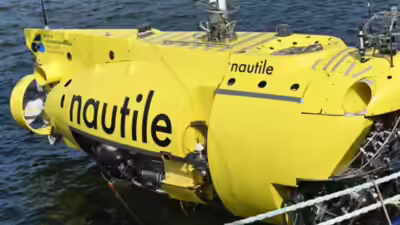India Achieves Milestone in Deep-Sea Exploration: Samudrayaan Project

India Achieves Milestone in Deep-Sea Exploration: Samudrayaan Project
Context:
- India successfully sent its first aquanauts to depths exceeding 5,000 metres in the North Atlantic Ocean, marking a major step towards its Deep Ocean Mission (DOM), also called Samudrayaan.
- This achievement follows shortly after India’s human spaceflight milestones under Gaganyaan, highlighting India’s dual frontier exploration – space and deep ocean.
Key Points:
- The Mission:
- Conducted in collaboration with France aboard the submersible Nautile.
- Two Indian aquanauts: Cdr (Retd) Jatinder Pal Singh (5,002 m) and R Ramesh (4,025 m).
- Dives carried out on 4–5 August 2025.
- Other NIOT engineers participated in operational support.
- Significance:
- India joins a select group of countries with deep-sea exploration capability: USA, Russia, China, Japan, France.
- The dives provide experience for India’s indigenous submersible, Matsya 6000, expected operational by 2027, capable of carrying 3 humans to 6,000 m.
- Strengthens India’s blue economy initiatives, including deep-sea resource exploration and marine biodiversity research.
- Technical Details:
- Matsya 6000: Titanium-alloy personnel sphere (2.1 m diameter) capable of sustaining life for 12-hour missions (emergency support up to 96 hours).
- Equipped with scientific instruments, communication systems, robotic arms, and life-support systems including oxygen rebreathers and CO₂ scrubbers.
- Development challenges: extreme pressure (~600 atm at 6,000 m), precise electron beam welding, environmental control, and acoustic communication in deep water.
- Objectives of Samudrayaan/DOM:
- Deep-sea resource utilization: Polymetallic nodules containing nickel, cobalt, rare earths.
- Marine research: Biodiversity exploration and climate change observations.
- Technology development: Submersibles, underwater robotics, energy and freshwater extraction from oceans.
- Capacity building: Advanced marine stations for ocean sciences.
- Political and Strategic Significance:
- Showcases India’s technological capability and self-reliance in deep ocean exploration.
- Positions India strategically in global ocean governance and blue economy sectors.
- Union Minister of Earth Sciences Jitendra Singh termed it part of India’s “double conquest” – space and deep ocean.
Additional Info:
- Total coastline of India: 11,098 km.
- Samudrayaan is one of six components of the Deep Ocean Mission approved by the Union Cabinet in 2021.
- Estimated cost: ₹4,077 crore over five years.
Updated: Aug 14, 2025, 18:25 PM | TOI